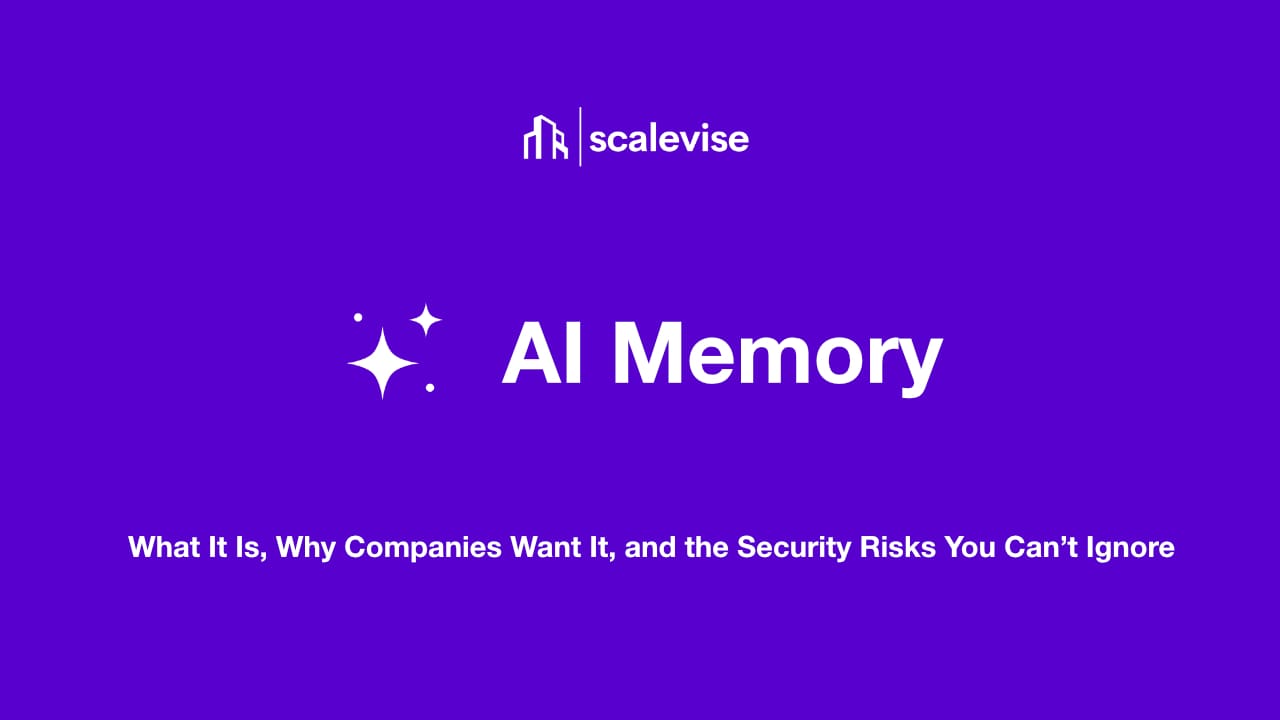AI Memory: What It Is, Why Companies Want It, and the Security Risks You Can’t Ignore

AI memory is fast becoming one of the most debated features in artificial intelligence development. From enhancing productivity to personalizing workflows, the idea of an AI assistant that “remembers” is appealing for almost every industry. But with every benefit comes a set of risks that can’t be brushed aside.
At Scalevise we work with companies to design AI stacks that fit their operational goals without compromising on security or compliance. This article breaks down what AI memory actually means, why organizations are adopting it, and the hidden security implications business leaders need to consider before rolling it out.
💡 Also See: AI Session Memory
What Is AI Memory, Exactly?
AI memory refers to the ability of an AI system to retain information from past interactions and use it in future responses. It moves the AI from a purely stateless model where every conversation starts from zero to a stateful one that can:
- Recall specific facts about a user or project.
- Maintain long-term context across multiple sessions.
- Adapt tone, style, or recommendations based on historical preferences.
There are two main types:
- Short-Term (Session) Memory
Context is retained for the duration of a conversation but is lost when the session ends. This is the most common form, and it’s relatively low-risk because data doesn’t persist. - Long-Term (Persistent) Memory
The AI stores information over time and reuses it across sessions. This is where personalization becomes powerful and where security and privacy risks begin to multiply.
For an in-depth look at AI tools with different memory approaches, see our AI Agents Overview.
Why Companies Want AI Memory
For businesses, AI memory is not just a convenience it’s a competitive advantage.
1. Enhanced Efficiency
AI memory reduces the need to repeat information. Instead of re-explaining workflows or customer requirements, the assistant can recall and act on prior instructions instantly.
2. Personalization at Scale
An AI that remembers preferences, project details, and communication styles can adapt to individual users or departments. This creates a tailored experience without constant reconfiguration.
3. Faster Onboarding
When a new employee interacts with an AI tool that already “knows” the company’s processes, onboarding becomes smoother. The assistant can guide them through procedures without manual setup.
4. Cross-Project Intelligence
In environments like sales, customer service, or product development, AI memory can connect dots across projects. This can uncover patterns that lead to better decision-making.
If you’re looking to integrate AI memory into customer service, check out our guide on Automated Onboarding with Make.com.
The Security and Privacy Risks
While AI memory unlocks significant potential, it also opens the door to serious risks if not designed and managed carefully.
1. Data Retention and Compliance
Long-term AI memory means data is stored somewhere often in third-party systems. This raises immediate compliance questions for regulations like GDPR, CCPA, or HIPAA.
Without strict retention policies, companies could find themselves liable for storing sensitive information longer than allowed.
2. Unauthorized Access
If AI memory contains confidential data and the system is compromised, attackers could gain insights into company operations, customer records, or intellectual property.
Unlike static databases, AI memory might hold contextually linked data that’s harder to detect but just as sensitive.
3. Profiling and Ethical Concerns
Persistent memory can lead to the creation of detailed user profiles, sometimes without explicit consent. This not only risks violating privacy laws but can erode trust among employees and customers.
4. Inaccurate or Outdated Data
Memory is only useful if it’s correct. If the AI retains outdated information, it can make flawed recommendations and the user might not realize the source is bad memory rather than faulty reasoning.
The Balance Between Usefulness and Safety
At Scalevise, we see AI memory as a double-edged sword. Used responsibly, it can transform operations. Used recklessly, it can become a compliance and security nightmare.
The key is control:
- Opt-In Memory — Let users decide what gets remembered.
- Scoped Context — Store memory per project or department, not globally.
- Retention Policies — Define clear timelines for when data is deleted.
- Audit Trails — Keep logs of what’s stored and when it’s accessed.
Our AI and Data Privacy Guide goes deeper into these governance principles.
How We Help Companies Approach AI Memory
When we build AI solutions for clients, we take a structured approach to deciding if and how memory should be used:
- Assess the Business Need
Is memory truly necessary, or can short-term context handle the use case? - Map Data Flows
Identify exactly what will be stored, where it will live, and how it can be secured. - Select the Right Model
Some AI providers (like Anthropic with Claude) offer privacy-first, on-demand memory. Others focus on always-on personalization. The choice depends on compliance and operational goals. - Implement Guardrails
This includes encryption, role-based access, and automated deletion routines. - Ongoing Review
AI memory should be audited like any other data store. We help companies run periodic checks to ensure security policies are still met.
The Future of AI Memory
The direction is clear: more AI systems will adopt persistent memory because it makes them more useful and competitive. But as this happens, the gap between convenience and compliance will only widen.
Businesses that get this right will not only see efficiency gains but also build a foundation of trust with users and regulators. Those that ignore the risks may find themselves in headlines for all the wrong reasons.
Bottom Line:
AI memory can be a game-changer but only if deployed with a clear understanding of its benefits and risks. At Scalevise, our role is to help you choose the right AI stack and configure it so memory works for your business, not against it.
Ready to explore AI memory for your workflows?
Contact us at https://scalevise.com/contact.
